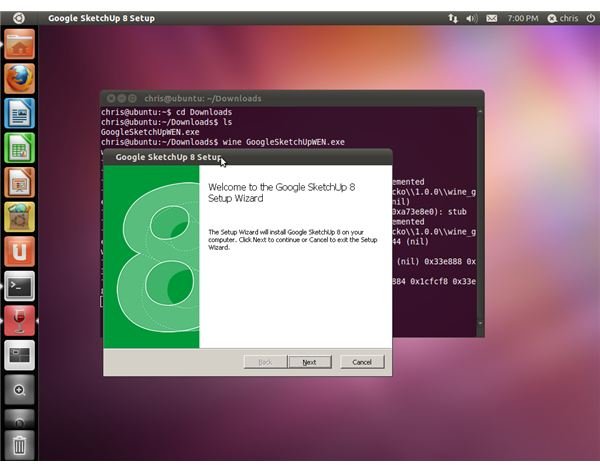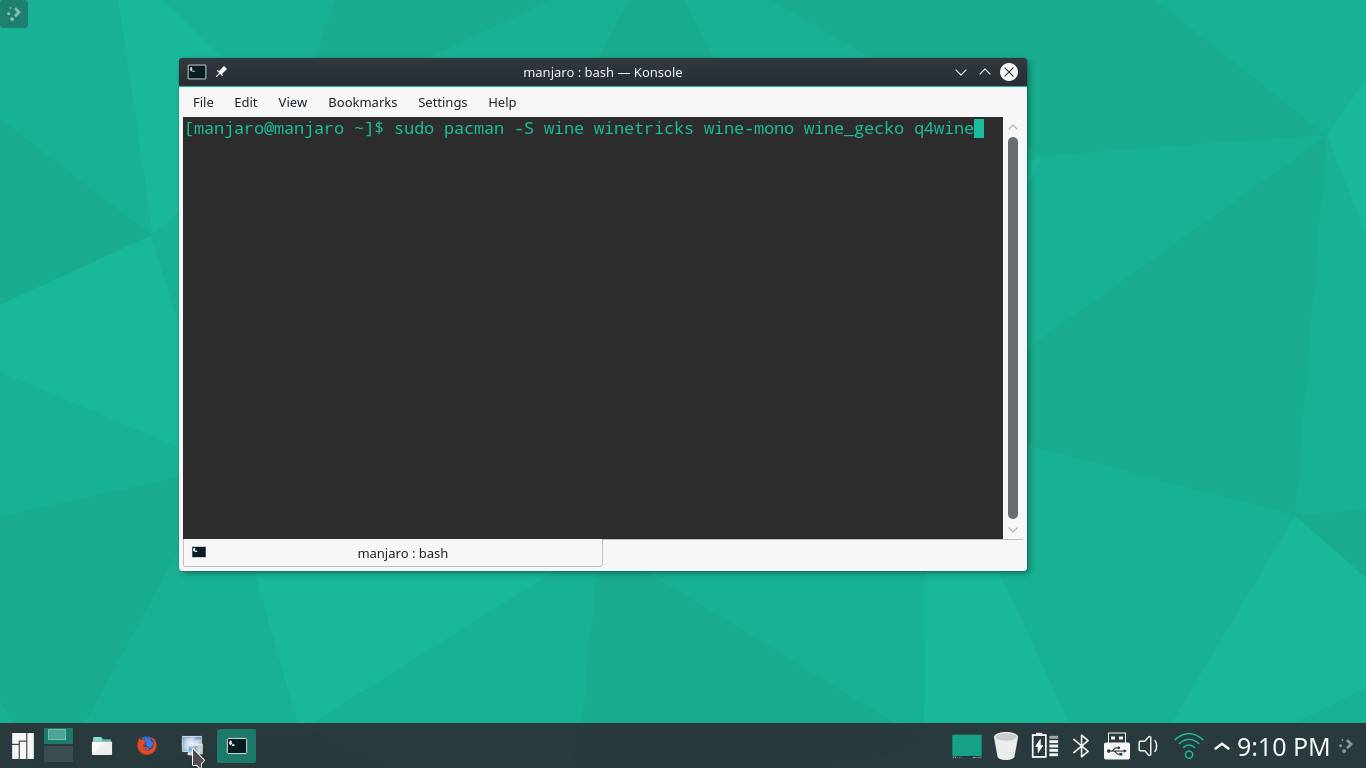Install Wine From Terminal Mac
A front-end launcher program for Foobar2000 on Mac OS X that is running under WINE. If you have wine installed, this script merely creates a launcher app for running foobar2000, therefore Foobar2000mac is now accessible in Launchpad and/or can be pinned to your Dock.
- Install Wine From Terminal Mac Command
- Install Wine From Terminal Mac Ip
- Install Wine From Terminal Mac Address
- Install Wine In Terminal
- Mac Os Terminal Install Command
Anyone who wants to run Foobar2000 using the MS Windows compatibility layer called Wine and have a easy to use launcher program to start it. The benefits of this approach are
First grab a copy of foobar2000's installer here via foobar2000.org
Homebrew Method:
- Homebrew and WINE - See setup guide below
- foobar2000Mac Launcher.app Download Brew Version
Open Terminal and run the following command to delete Wine: brew uninstall wine. Homebrew, previously installed to install Wine, will then remove Wine from your Mac. However, you need to keep in mind that you’ve also installed a list of other packages crucial to keeping Wine running correctly. Jan 15, 2020 macOS Recovery makes it easy to reinstall the Mac operating system, even if you need to erase your startup disk first. All you need is a connection to the Internet. If a wireless network is available, you can choose it from the Wi-Fi menu in the menu bar. This menu is also available in macOS Recovery. Jul 13, 2019 In this tutorial, you will learn how to install Wine 4.0 on CentOS 7 using the source code or EPEL Repository. Prerequisites Access to a command-line/terminal window. Apr 06, 2020 And by this Wine Catalina Installation you’ll be able to Run Windows Software in your Mac Computer! Because Wine (originally an acronym for “Wine Is Not an Emulator”) is a Compatibility Layer capable of Running Windows Apps on several POSIX-compliant OSes systems, such as Linux, Mac OSX, &. Mar 05, 2017 Video learning. This video will show you how to install Wine on Mac OS. This software allow us to run file exe on Mac OS. Please like and subscribe my video.
MacPorts Method Garageband pc download.
- MacPorts and WINE - See setup guide below
- foobar2000Mac Launcher.app Download MacPorts Version
How-to: Download the launcher, unzip it, and drag it into the Applications folder. Next, access it with Launchpad, Spotlight, Alfred and even pin to the Dock.
- Homebrew Version foobar2000Mac Launcher.app
- Macports Version foobar2000Mac Launcher.app

Brew is easier to setup and use. Go here for the Brew & Wine Setup Guide
If you have Wine already installed, then skip to Step 4. Otherwise you should know that setting this up is not for the faint of heart, but you will learn much along the way. Installing X11, Java RE, MacPorts, Xcode, Wine is a bit time consuming, but it is worth it.Things go more smoothly by following this setup order:
X11 must be installed. If you don't know what it is or never installed it on your Mac (it's a seperate OS X add-on Apple releases), then go grab it from this website here:
Java Runtime Environment (JRE) must be installed. Check to see if Java is installed by opening a terminal and typing:
java -version
If you do have Java installed, then it will show you what version you have,
Its automatic loop is the seamless and synchronized sampler lets the user perform astounding remixes live and with no preparation anymore. Its sandbox is the unique feature lets the user prepare your next mix while the audience is still listening to the song.  This advanced presentation has the visual cues that permit the user to allow a DJ to see the song structure clearly and never be surprised all the time. It’s one of the most exclusive features is Sandbox that is for sure the genuine concept. Its vinyl handles will let user scratch like on a turntable that is real except that with leat lock engine.
This advanced presentation has the visual cues that permit the user to allow a DJ to see the song structure clearly and never be surprised all the time. It’s one of the most exclusive features is Sandbox that is for sure the genuine concept. Its vinyl handles will let user scratch like on a turntable that is real except that with leat lock engine.
otherwise, download and install the JRE from here:
- MacPorts must be installed. Ports gives you access to a repository like Linux has to find, install, and update thousands of free *nix programs that Apple left out. It does this by grabbing the software code required to build into a runnable program, builds, and installs it. It may take longer than downloading and installing a program that is ready to install, but programs and their dependencies are more likely to run better and faster, since it was built for your exact setup instead of being built for all setups. Download it here:

This has a few steps which cost nothing but time, which are
Once MacPorts is installed, then in a terminal use these command to update Ports, then install Wine:
sudo port selfupdatesudo port upgrade outdated
Note:If installing a new port program or upgrading outdated fails, restart your computer and try again.This will clear out your system temp folder, and it will often fix any install problems.
Depending on the speed of your computer, it might take a few hours to build and install wine, along with all it's resources it requires.
If you want to search for other Port programs use this command
Grab a copy of foobar2000. Download it here:
foobar2000.org
Run wine to launch the Foobar2000 installer. In the terminal:
wine Downloads/foobarinstaller.exe
Finally, install the launcher app by copying Foobar2000mac.app into your Application folder. Next,
- If you want it to stay in your Dock, then drag it onto it from the Applications folder
- If you want it to be findable in Launchpad, then drag it onto it from the Applications folder
If you prefer a simplier way get Foobar2000 running on OS X, then maybe CrossOver is a better choice, but doing so you won't have the MacPorts repository of programs you can natively build and install.
Reinstall from macOS Recovery
macOS Recovery makes it easy to reinstall the Mac operating system, even if you need to erase your startup disk first. All you need is a connection to the Internet. If a wireless network is available, you can choose it from the Wi-Fi menu in the menu bar. This menu is also available in macOS Recovery.
1. Start up from macOS Recovery
To start up from macOS Recovery, turn on your Mac and immediately press and hold one of the following combinations on your keyboard. Release the keys when you see an Apple logo, spinning globe, or other startup screen.
Command (⌘)-R
Reinstall the latest macOS that was installed on your Mac (recommended).
Option-⌘-R
Upgrade to the latest macOS that is compatible with your Mac.
Shift-Option-⌘-R
Reinstall the macOS that came with your Mac, or the closest version still available.
Install Wine From Terminal Mac Command
You might be prompted to enter a password, such as a firmware password or the password of a user who is an administrator of this Mac. Enter the requested password to continue.
When you see the utilities window, you have started up from macOS Recovery.
2. Decide whether to erase (format) your disk
You probably don't need to erase, unless you're selling, trading in, or giving away your Mac, or you have an issue that requires you to erase. If you need to erase before installing macOS, select Disk Utility from the Utilities window, then click Continue. Learn more about when and how to erase.
3. Install macOS
When you're ready to reinstall macOS, choose Reinstall macOS from the Utilities window. Then click Continue and follow the onscreen instructions. You will be asked to choose a disk on which to install.
- If the installer asks to unlock your disk, enter the password you use to log in to your Mac.
- If the installer doesn't see your disk, or it says that it can't install on your computer or volume, you might need to erase your disk first.
- If the installer is for a different version of macOS than you expected, learn about macOS Recovery exceptions.
Please allow installation to complete without putting your Mac to sleep or closing its lid. During installation, your Mac might restart and show a progress bar several times, and the screen might be empty for minutes at a time.
If your Mac restarts to a setup assistant, but you're selling it, trading it in, or giving it away, press Command-Q to quit the assistant without completing setup. Then click Shut Down. When the new owner starts up the Mac, they can use their own information to complete setup.
Install Wine From Terminal Mac Ip
macOS Recovery exceptions
Install Wine From Terminal Mac Address
The version of macOS offered by macOS Recovery might differ in certain circumstances:
- If macOS Sierra 10.12.4 or later has never been installed on this Mac, Option-Command-R installs the macOS that came with your Mac, or the closest version still available. And Shift-Option-Command-R isn't available.
- If you erased your entire disk instead of just the startup volume on that disk, macOS Recovery might offer only the macOS that came with your Mac, or the closest version still available. You can upgrade to a later version afterward.
- If your Mac has the Apple T2 Security Chip and you never installed a macOS update, Option-Command-R installs the latest macOS that was installed on your Mac.
- If you just had your Mac logic board replaced during a repair, macOS Recovery might offer only the latest macOS that is compatible with your Mac.
If you can't get macOS Recovery to offer the installer you want, you might be able to use one of the other ways to install macOS.
Install Wine In Terminal
Other ways to install macOS
Mac Os Terminal Install Command
- You can also install macOS from the App Store or Software Update preferences. If you can't install macOS Catalina, you might be able to install an earlier macOS, such as macOS Mojave, High Sierra, Sierra, El Capitan, or Yosemite.
- Or create a bootable installer disk, then use that disk to install macOS on your Mac or another Mac.